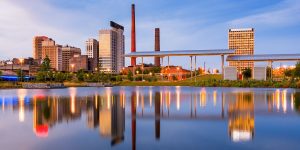
About Birmingham
Birmingham was born out of the iron and steel industry. Remnants of those early beginnings are preserved in places such as Sloss Furnaces National Historic Landmark and Vulcan Park & Museum. The city is also well known for its prominent role in America’s Civil Rights Movement of the 1960s. A visit to the Birmingham Civil Rights Institute gives visitors an in-depth look at that important era.
Today, Birmingham wears a much different face. It’s a place that’s brimming with entertainment, the arts, nightlife, outdoor recreation and world-class cuisine.
Should you have Birmingham pigeonholed as serving only barbecue and fried pies, remember that the city is home to “the Oscars of dining,” with James Beard Foundation Award winners and nominees. Visitors to the city should take in the beauty of down-home cooking as well. And guests with an appetite for live music have come to the right place.
The area’s antique shops are featured in upscale lifestyle magazines around the country. Trendy malls have taken root, bringing tony, high-end shops to the state’s retail giant. Dozens of art galleries surprise enthusiasts and collectors with a spectrum of paintings, sculpture, jewelry, ceramics, fine and folk art. The Birmingham Museum of Art houses an impressive collection of artistic work from cultures around the world.
With a comfortable climate nearly year-round, Birmingham attracts outdoor advocates to play golf along two courses on the state’s Robert Trent Jones Golf Trail. Biking, hiking and mountain climbing are popular activities, along with family gatherings in green spaces like Railroad Park downtown.
It is a potpourri of experiences that is the city’s greatest strength and strongest appeal. We are a medley of cultures and attitudes that blend beautifully with the Southern charm that is Birmingham.
Check out Taj Mahal’s Sweet Birmingham
History
Though Birmingham stands in the heart of the Deep South, it’s not an Old South city.
Founded in 1871 at the crossing of two railroad lines, the city blossomed through the early 1900s, growing so rapidly that people said it was “just like magic,” earning the new town the name “The Magic City.” Iron and steel production were a natural for Birmingham; underground lay abundant key ingredients—coal, limestone and iron ore. As an industrial town, Birmingham suffered greatly during the Depression. After World War II, the city grew moderately while retaining its strong Southern character.


Long known for its considerable role in the Civil Rights Movement of the 1960s, Birmingham has matured, embracing the impact of the past, both positive and negative. Opened in 1993, the Birmingham Civil Rights Institute is a moving and educational example of how a city found a way to heal.
Looking at Birmingham today, there is little evidence of the scarring. Today’s social scene sees folks of all ethnic backgrounds enjoying and learning from one another, arguing issues of the day, and sharing professional and personal time together in a new social era.
Civil Rights
Long known as a city of civil rights conflict and reconciliation, Birmingham has matured into a city that acknowledges and embraces the impact of our past, both negative and positive. Opened in the 1990s, the Birmingham Civil Rights Institute is a moving and educational example of how a city found a way to heal itself. Looking at the city today, there is little evidence of the scarring, though it will always be with us. Todays social scene is the picture of diversity as well, with folks of all ethnic backgrounds enjoying and learning from one another, arguing issues of the day, and sharing professional and social time together in an era that has made the old days almost invisible.







